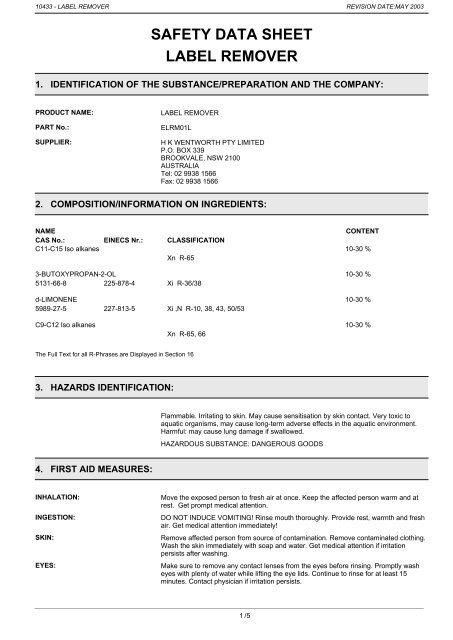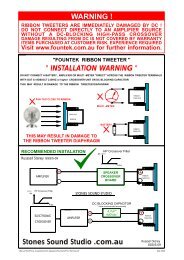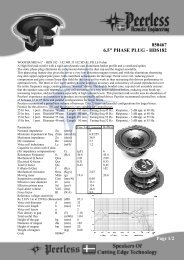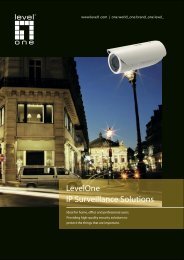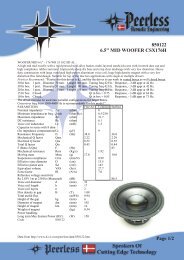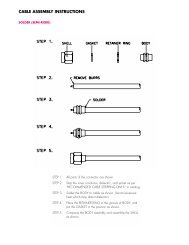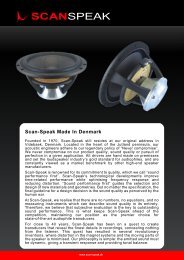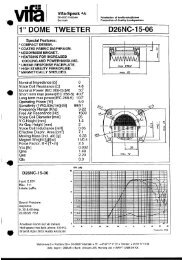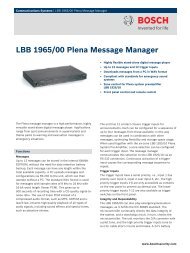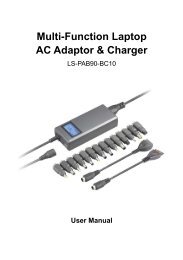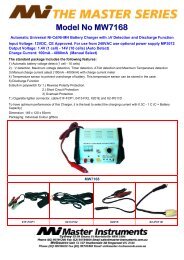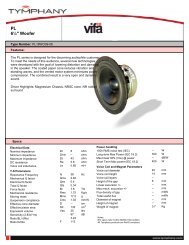SAFETY DATA SHEET LABEL REMOVER - WES Components
SAFETY DATA SHEET LABEL REMOVER - WES Components
SAFETY DATA SHEET LABEL REMOVER - WES Components
Create successful ePaper yourself
Turn your PDF publications into a flip-book with our unique Google optimized e-Paper software.
10433 - <strong>LABEL</strong> <strong>REMOVER</strong> REVISION DATE:MAY 2003<br />
<strong>SAFETY</strong> <strong>DATA</strong> <strong>SHEET</strong><br />
<strong>LABEL</strong> <strong>REMOVER</strong><br />
1. IDENTIFICATION OF THE SUBSTANCE/PREPARATION AND THE COMPANY:<br />
PRODUCT NAME:<br />
PART No.:<br />
SUPPLIER:<br />
<strong>LABEL</strong> <strong>REMOVER</strong><br />
ELRM01L<br />
H K WENTWORTH PTY LIMITED<br />
P.O. BOX 339<br />
BROOKVALE, NSW 2100<br />
AUSTRALIA<br />
Tel: 02 9938 1566<br />
Fax: 02 9938 1566<br />
2. COMPOSITION/INFORMATION ON INGREDIENTS:<br />
NAME<br />
CAS No.:<br />
C11-C15 Iso alkanes<br />
EINECS Nr.:<br />
CLASSIFICATION<br />
Xn R-65<br />
CONTENT<br />
10-30 %<br />
3-BUTOXYPROPAN-2-OL<br />
5131-66-8<br />
225-878-4 Xi R-36/38<br />
10-30 %<br />
d-LIMONENE<br />
5989-27-5<br />
C9-C12 Iso alkanes<br />
227-813-5 Xi ,N R-10, 38, 43, 50/53<br />
Xn R-65, 66<br />
10-30 %<br />
10-30 %<br />
The Full Text for all R-Phrases are Displayed in Section 16<br />
3. HAZARDS IDENTIFICATION:<br />
Flammable. Irritating to skin. May cause sensitisation by skin contact. Very toxic to<br />
aquatic organisms, may cause long-term adverse effects in the aquatic environment.<br />
Harmful: may cause lung damage if swallowed.<br />
HAZARDOUS SUBSTANCE: DANGEROUS GOODS<br />
4. FIRST AID MEASURES:<br />
INHALATION:<br />
INGESTION:<br />
SKIN:<br />
EYES:<br />
Move the exposed person to fresh air at once. Keep the affected person warm and at<br />
rest. Get prompt medical attention.<br />
DO NOT INDUCE VOMITING! Rinse mouth thoroughly. Provide rest, warmth and fresh<br />
air. Get medical attention immediately!<br />
Remove affected person from source of contamination. Remove contaminated clothing.<br />
Wash the skin immediately with soap and water. Get medical attention if irritation<br />
persists after washing.<br />
Make sure to remove any contact lenses from the eyes before rinsing. Promptly wash<br />
eyes with plenty of water while lifting the eye lids. Continue to rinse for at least 15<br />
minutes. Contact physician if irritation persists.<br />
1 /5
10433 - <strong>LABEL</strong> <strong>REMOVER</strong> REVISION DATE:MAY 2003<br />
5. FIRE FIGHTING MEASURES:<br />
EXTINGUISHING MEDIA:<br />
SPECIAL FIRE FIGHTING<br />
PROCEDURES:<br />
Fire can be extinguished using: Foam. Dry chemicals, sand, dolomite etc.<br />
Avoid breathing fire vapours. Cool containers exposed to flames with water until well<br />
after the fire is out. Keep run-off water out of sewers and water sources. Dike for water<br />
control.<br />
6. ACCIDENTAL RELEASE MEASURES:<br />
SPILL CLEANUP METHODS:<br />
Extinguish all ignition sources. Avoid sparks, flames, heat and smoking. Ventilate.<br />
Clean-up personnel should use respiratory and/or liquid contact protection. Absorb in<br />
vermiculite, dry sand or earth and place into containers.<br />
7. HANDLING AND STORAGE:<br />
USAGE PRECAUTIONS:<br />
STORAGE PRECAUTIONS:<br />
STORAGE CRITERIA:<br />
Avoid spilling, skin and eye contact. Keep away from heat, sparks and open flame.<br />
Ventilate well, avoid breathing vapours. Use approved respirator if air contamination is<br />
above accepted level. Use explosion proof electric equipment.<br />
Flammable/combustible - Keep away from oxidizers, heat and flames. Keep in cool,<br />
dry, ventilated storage and closed containers. Keep in original container.<br />
Flammable liquid storage.<br />
8. EXPOSURE CONTROLS AND PERSONAL PROTECTION:<br />
INGREDIENT COMMENTS:<br />
OES = Occupational Exposure Standard.<br />
PROTECTIVE EQUIPMENT:<br />
VENTILATION:<br />
RESPIRATORS:<br />
PROTECTIVE GLOVES:<br />
EYE PROTECTION:<br />
OTHER PROTECTION:<br />
HYGIENIC WORK PRACTICES:<br />
Provide adequate general and local exhaust ventilation.<br />
Respiratory protection must be used if air concentration exceeds acceptable level.<br />
Use protective gloves.<br />
Use approved safety goggles or face shield.<br />
Wear appropriate clothing to prevent any possibility of liquid contact and repeated or<br />
prolonged vapour contact.<br />
DO NOT SMOKE IN WORK AREA! Wash at the end of each work shift and before<br />
eating, smoking and using the toilet. Wash promptly with soap & water if skin becomes<br />
contaminated. Promptly remove any clothing that becomes contaminated. Use<br />
appropriate skin cream to prevent drying of skin. No eating or drinking while working<br />
with this material.<br />
9. PHYSICAL AND CHEMICAL PROPERTIES:<br />
APPEARANCE:<br />
Liquid. Clear.<br />
2 /5
10433 - <strong>LABEL</strong> <strong>REMOVER</strong> REVISION DATE:MAY 2003<br />
COLOUR:<br />
ODOUR/TASTE:<br />
BOILING POINT (°C, interval):<br />
DENSITY/SPECIFIC GRAVITY<br />
(g/ml):<br />
SOLUBILITY DESCRIPTION:<br />
FLASH POINT (°C):<br />
Colourless.<br />
Lemon.<br />
>100 Pressure:<br />
0.820 - 0.840 Temperature (°C): 20<br />
Insoluble in water.<br />
200<br />
FLAMMABILITY LIMIT - LOWER(%): 0.7<br />
FLAMMABILITY LIMIT - UPPER(%): 8.3<br />
10. STABILITY AND REACTIVITY:<br />
STABILITY:<br />
CONDITIONS TO AVOID:<br />
HAZARDOUS DECOMP.<br />
PRODUCTS:<br />
Normally stable.<br />
Avoid heat. Avoid contact with oxidisers or reducing agents.<br />
Fire creates: Toxic gases/vapours/fumes of: Carbon monoxide (CO). Carbon dioxide<br />
(CO2).<br />
11. TOXICOLOGICAL INFORMATION:<br />
INHALATION:<br />
INGESTION:<br />
SKIN:<br />
EYES:<br />
ROUTE OF ENTRY:<br />
Solvent vapours are hazardous and may cause nausea, sickness and headaches. High<br />
concentrations of vapours may irritate respiratory system and lead to headache,<br />
fatigue, nausea and vomiting.<br />
Harmful: may cause lung damage if swallowed.<br />
Irritating to skin. May cause sensitisation by skin contact. Product has a defatting effect<br />
on skin. Prolonged or repeated contact leads to drying of skin.<br />
Irritating to eyes.<br />
Inhalation.<br />
Skin absorption.<br />
12. ECOLOGICAL INFORMATION:<br />
ECOLOGICAL INFORMATION:<br />
Dangerous for the environment if discharged into watercourses.<br />
13. DISPOSAL CONSIDERATIONS:<br />
DISPOSAL METHODS:<br />
Dispose of in accordance with Local Authority requirements.<br />
14. TRANSPORT INFORMATION:<br />
<strong>LABEL</strong> FOR CONVEYANCE:<br />
3 /5
10433 - <strong>LABEL</strong> <strong>REMOVER</strong> REVISION DATE:MAY 2003<br />
UN No. ROAD: 1993<br />
UK ROAD TRANSPORT CLASS: 3<br />
UK ROAD PACK GR.:<br />
III<br />
ADR CLASS No.: 3<br />
ADR CLASS:<br />
ADR ITEM No.:<br />
Class 3: Flammable liquids.<br />
III<br />
ADR MARGINAL: 2301<br />
ADR <strong>LABEL</strong> No.: 3<br />
HAZCHEM CODE:<br />
CEFIC TEC(R) No.:<br />
PROPER SHIPPING NAME I:<br />
3Y<br />
30GF1-III,30GF1-sp<br />
FLAMMABLE LIQUID, N.O.S. (d-LIMONENE)<br />
RID CLASS No.: 3<br />
RID ITEM No.:<br />
III<br />
UN No. SEA: 1993<br />
IMDG CLASS: 3<br />
IMDG PAGE No.: 3230<br />
IMDG PACK GR.:<br />
EmS No.:<br />
MFAG TABLE No.:<br />
MARINE POLLUTANT:<br />
III<br />
F-E; S-E<br />
See Guide<br />
No.<br />
UN No., AIR: 1993<br />
ICAO CLASS: 3<br />
AIR PACK GR.:<br />
III<br />
15. REGULATORY INFORMATION:<br />
<strong>LABEL</strong> FOR SUPPLY:<br />
RISK PHRASES:<br />
R-10 Flammable.<br />
R-38 Irritating to skin.<br />
R-43 May cause sensitisation by skin contact.<br />
R-50/53 Very toxic to aquatic organisms, may cause long-term adverse effects in the<br />
aquatic environment.<br />
R-65 Harmful: may cause lung damage if swallowed.<br />
4 /5
10433 - <strong>LABEL</strong> <strong>REMOVER</strong> REVISION DATE:MAY 2003<br />
<strong>SAFETY</strong> PHRASES:<br />
STATUTORY INSTRUMENTS:<br />
APPROVED CODE OF PRACTICE:<br />
GUIDANCE NOTES:<br />
S-24 Avoid contact with skin.<br />
S-37 Wear suitable gloves.<br />
S-51 Use only in well ventilated areas.<br />
Chemicals (Hazard Information and Packaging) Regulations. Control of Substances<br />
Hazardous to Health.<br />
Classification and Labelling of Substances and Preparations Dangerous for Supply.<br />
Occupational Exposure Limits EH40. Introduction to Local Exhaust Ventilation<br />
HS(G)37. CHIP for everyone HSG(108).<br />
16. OTHER INFORMATION:<br />
USER NOTES: CN No 38140090<br />
REVISION COMMENTS:<br />
ISSUED BY:<br />
Revised in accordance with CHIP3 and EU Directive 1999/45/EC<br />
Helen O'Reilly<br />
REVISION DATE: MAY 2003<br />
REV. No./REPL. SDS GENERATED: 0<br />
SDS No.: 10433<br />
DISCLAIMER:<br />
R-PHRASES (Full Text):<br />
This information relates only to the specific material designated and may not be valid<br />
for such material used in combination with any other materials or in any process unless<br />
specified in the text. The information contained in this safety data sheet is correct to the<br />
best of our knowledge, information and belief at the date of its publication. The<br />
information given is designed only as guidance for the safe handling, use, processing,<br />
storage, transportation, disposal and release and is not to be considered a warranty or<br />
quality specification<br />
R-65 Harmful: may cause lung damage if swallowed. R-66 Repeated exposure may<br />
cause skin dryness or cracking. R-36/38 Irritating to eyes and skin. R-10 Flammable.<br />
R-38 Irritating to skin. R-43 May cause sensitisation by skin contact. R-50/53 Very toxic<br />
to aquatic organisms, may cause long-term adverse effects in the aquatic environment.<br />
5 /5


